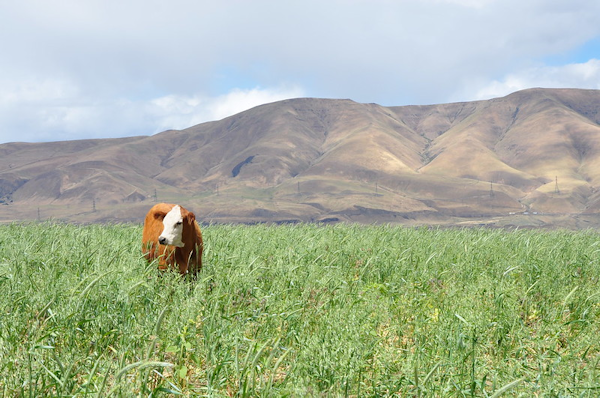SEJournal Online is the digital news magazine of the Society of Environmental Journalists. Learn more about SEJournal Online, including submission, subscription and advertising information.
 |
| The U.S. government for decades has used incentives and training to encourage farmers to improve the stability and resilience of their land. Above, an Oregon farm uses a cover crop to improve soil health. Photo: USDA Natural Resources Conservation Service Oregon via Flickr Creative Commons (CC BY-ND 2.0). |
Issue Backgrounder: Why the 2023 Farm Bill Will Actually Be an Environmental Story — and a Huge One
By Joseph A. Davis
Congress will be wrestling over the farm bill this year, and it may be the biggest legislative story of 2023. The farm and ag press will follow it — and environmental journalists should too.
Every five years the farm bill props up commodity prices and pays farmers for not growing crops. But as must-pass vehicles, they attract all kinds of specialized provisions.
Historically the legislation has been loaded with important provisions affecting natural resources, environmental health and climate. This year may be more so.
The Dust Bowl of the 1930s
etched into the minds of
many farmers the need for
land and water conservation.
The Dust Bowl of the 1930s etched into the minds of many farmers the need for land and water conservation. For many farmers much of the time, that is good business. When crop prices are low, at least. When crop prices are high, they often want to plant fencerow to fencerow. That can be bad for the environment.
So in the years since, the federal government (largely through the U.S. Department of Agriculture) has encouraged farmers to improve the stability and resilience of their land. In practical terms, that means things like contour plowing, farm ponds, cover crops and, especially, the many other things that reduce soil erosion.
The USDA also helped farmers for decades with technical advice — and funding — to put those practices in place. For a long time, most of that work was done by the USDA’s Soil Conservation Service (now the Natural Resources Conservation Service). Start by looking at some of its major programs.
Oh — did we mention that a lot of farmers and ranchers don’t like people telling them what they can do with their land? Especially the government. In practical terms, this has meant that most USDA conservation programs have used monetary incentives rather than coercive regulation.
Weighing in on climate, forestry, wildfire
Meanwhile, a lot of farm bill provisions may affect climate.
For instance, everybody is now talking about “regenerative” agriculture (although it’s not really new). At its simplest (although it’s far from simple), it involves building healthy soil by putting crop and animal waste back on the land.
Keeping soil (and its carbon) on
the land instead of letting it
wash down the river helps
limit climate change.
Healthy soil and ecosystems store a lot of carbon. So keeping soil (and its carbon) on the land instead of letting it wash down the river helps limit climate change.
Also prominent among climate-related policies in the farm bill are those around “biofuels.” For years, the feds have supported corn-based ethanol by requiring it to be mixed with gasoline for vehicles. Corn growers really love this because it props up the price of corn. Environmental analysts say the climate impact is minimal.
Meanwhile, timber is viewed as just another crop. The U.S. manages more of the approximately 193 million acres of national forests and grasslands for producing wood than it does for preserving wilderness.
 |
| Ethanol has been a prominent climate-related policy consideration in past farm bills, although its benefits are disputed. Above, a federal biofuels researcher. Photo: U.S. Department of Energy, via Flickr Creative Commons (U.S. Government Work). |
The U.S. Forest Service, or USFS, organized as a bureau of the USDA, manages most national forests under the Forest Service’s Organic Act and other laws for multiple uses — from timber and grazing to recreation and mineral production.
So, likely to raise controversy this year — it always does — is the management of USFS land in the face of climate-fueled wildfire. Heat, drought, disease and overgrowth have worsened wildfires, and the encroachment of residential structures into wildland have made fires more damaging to humans.
For many decades wildfires caused catastrophic damage, and government policy emphasized preventing them and putting them out immediately. This caused a buildup of fuel — making eventual fires worse.
In more recent years, the thinking has changed, and agencies often take a let-it-burn approach to fires that do not threaten humans or their structures. There is still debate about this. The farm bill may weigh in.
But over the years Congress has finagled the funding of the massive annual effort to fight wildfires. The idea that they are “disasters” has led to the funding of firefighting through emergency (“supplemental”) appropriations. This can be a form of denial; at least it makes the farm bill look less expensive.
Focus on food and food programs
Of course, not everything in the farm bill is environmental. The bill focuses a lot of effort on commodity prices. These days, it is done mostly with crop “insurance,” and you can probably expect that to continue or expand. Also expect the bill to manipulate foreign trade rules that help U.S. farmers sell products abroad.
Historically, one of the federal missions with regard to agriculture has been to stabilize crop and food prices.
The “food stamp” program was started in 1939, when the Great Depression was still keeping commodity prices low and keeping low-income and unemployed people food-insecure. By taking commodity surpluses off the market, the program helped prop up commodity prices. And kept some people from starving.
Today, the food stamp program has evolved and is called the Supplemental Nutrition Assistance Program, or SNAP.
Also in the years since, other federal food programs have evolved — among them the well-known Women, Infants, and Children, or WIC, program, which is aimed at addressing child hunger at a phase of life when food insecurity can harm development. In 2020, the WIC program served about 50% of eligible infants.
The USDA has a list of other federal food programs (such as the school lunch program).
Given the domination of the House of Representatives by MAGA Republicans, we may see a renewed effort to cut food and nutrition support, or expand the work requirement.
Timing of passage is unclear
Both House and Senate ag committees have already started their year-long process of working up a farm bill. To date, this has mostly amounted to hearings and listening sessions. The big step will be when one of the two committees puts a draft bill on the table.
Congress is technically supposed to pass the farm bill by the end of the fiscal year, Sept. 30. Given the level of chaos in Congress, this does not always happen.
Theoretically, this isn’t a problem since Congress can pass temporary extensions (if they can find the votes). And if it does stretch into 2024, they can brag about it while campaigning (if they can finish it at all).
We don’t know for sure whether
the bitter partisan divisiveness that
threatens to overwhelm the House
will hobble the farm bill’s progress.
What we don’t know for sure is whether the bitter partisan divisiveness that threatens to overwhelm the House will hobble the farm bill’s progress.
Such things have happened in the past — for example, over food stamps. In 2018, conservative Republicans imposed a work requirement on recipients. Today, Republicans are also eager to find things to cut from the budget, and with Social Security and Medicare (apparently) off the table, food aid would be an easy target.
The House Agriculture Committee is newly chaired by Glenn "GT" Thompson (R-Pa.), himself a dairy farmer. His 2022 League of Conservation Voters score was a low 11%. He has been gathering input before putting a draft farm bill on the table. The ranking Dem on the panel is David Scott (D-Ga.).
The Senate Agriculture Committee is chaired by Debbie Stabenow (D-Mich.), who has managed a farm bill before. She, by contrast with Thompson, has a 2022 LCV score of 100%. The ranking Republican is John Boozman (R-Ark.).
Reporting resources
- American Farm Bureau Federation: The biggest lobby group for the ag industry. It includes a network of state farm bureaus.
- American Farmland Trust: A nonprofit advocacy group focused on preserving farmland for agriculture rather than other uses like residential development.
- Food & Water Watch: A nonprofit advocacy group aimed at reducing pollution of food and water, as well as focusing on the ag connection to climate.
- Environmental Working Group: A nonprofit advocacy group that follows issues like ag subsidies and chemical pesticides, often using databases.
- National Corn Growers Association: This group lobbies for one of the biggest U.S. crops and those who grow it. It supports ethanol.
- National Cattlemen’s Beef Association: A lobby group that supports many aspects of the beef industry.
- State agriculture departments: There is an ag department in every state. Yours may help with local angles.
- Food Tank: A nonprofit think tank that focuses on food issues from a broad and progressive viewpoint.
- Census of Agriculture: Run by USDA, this periodic census is a good source of comparatively reliable facts about ag in the U.S.
[Editor’s Note: For the latest headlines on the farm bill, follow EJToday and for further background, visit our Topics on the Beat pages on agriculture and the food system. Plus, for a look back at debate over the 2018 Farm Bill, see a Backgrounder and TipSheet.]
Joseph A. Davis is a freelance writer/editor in Washington, D.C. who has been writing about the environment since 1976. He writes SEJournal Online's TipSheet, Reporter's Toolbox and Issue Backgrounder, and curates SEJ's weekday news headlines service EJToday and @EJTodayNews. Davis also directs SEJ's Freedom of Information Project and writes the WatchDog opinion column.
* From the weekly news magazine SEJournal Online, Vol. 8, No. 12. Content from each new issue of SEJournal Online is available to the public via the SEJournal Online main page. Subscribe to the e-newsletter here. And see past issues of the SEJournal archived here.














 Advertisement
Advertisement 



